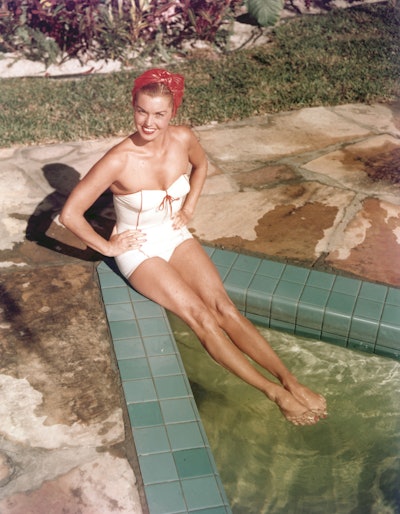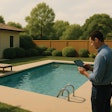
Even now, a half century after her last starring role, she remains the person most closely associated with the term “bathing beauty,” an icon for anyone who loves to swim as well for those who appreciate the glamour and sensationalism of movies from eras gone by.
Like many, I have my own special memories of the “Million Dollar Mermaid,” having interviewed her back in 1994 when I was an associate editor with Pool & Spa News. I was working on a long feature article covering the water-related life experiences of industry leaders. At the time, Williams had her own line of swimming pools and swimwear and was one of, if not the, most prominent person associated with the industry.
I called her office and was given a number I could use to reach her. At the time I had already interviewed a number of celebrities, mostly musicians in my side career as a rock journalist, and was familiar with the layers of hoops involved in setting up interviews with the rich and famous. When I dialed the number, I figured I’d be talking to a publicist or assistant, but much to my surprise, Williams herself picked up the phone. I said, “I’m calling to speak with Ms. Williams.”
I’ll never forget the sick tingling sensation that coursed through my psyche when she curtly replied, “This is Esther. How did you get this number?”
Apparently the woman who gave me the digits had mistakenly given me Ms. Williams’ personal phone line instead of her publicist’s office. After explaining who I was and what I wanted, she warmed up immediately and granted me an interview on the spot.
I was caught off guard, to say the least, but I hit record on my tape machine, snapped into my best interview mode and away we went. It would turn out to be one of the most entertaining discussions I’d ever had. She was passionate about swimming and the pool industry and was more than happy to answer all my questions. In fact, when I told her the angle of the story I was writing, she praised me for taking on such an important topic. She also commented that I sounded quite young for someone engaging such a discussion with a celebrity of her stature. (I was 33 at the time.)
I shamelessly appealed to her ego and said, “Who better to comment on the nature and importance of swimming than you?”

For the next hour plus, Esther Williams regaled me with her life story. I barely had to say another word and was satisfied to dutifully absorb the rich cavalcade of anecdotes she so openly shared. She was extremely opinionated and only slightly pretentious, referring often to her fellow stars, Liz, Frank and Fernando, among others. She had all the panache of a big-time star and the instincts of a great storyteller.
When we came to the subject of swimming itself, she lit up and launched into a wonderful diatribe about how swimming had transformed her life by giving her a body and level of athleticism that fueled her unique career in front of the camera. She talked about the innovative technologies developed for her movies, including a quarter million dollar pool on the MGM lot that was fitted with a hydraulic lift, lights and an array of fountain effects, an unprecedentedly complex system for the time. And she was particularly proud of the fact that the elaborate art of “water ballet” had given rise to the sport of synchronized swimming.
When we hung up, I was in something of a daze. I immediately replayed the tape for my co-workers to share in the buzz of having just interviewed a living legend. The next day, while transcribing the interview, the phone rang — and much to my surprise it, was Esther Williams calling. She said she greatly enjoyed our conversation and had a number of follow-up comments. More than an hour later, we were still talking, and by the end of the call we were joking and laughing like old friends, more or less.
I later met her in person at an industry event. She was in her 70s at the time, and she looked fantastic — still fit and beautiful, stately in her demeanor and extremely gracious to those around her, the definition of class. By then I had spoken with her on two more occasions and was thrilled when she addressed me by name. “Eric, it’s so nice to finally meet you in person.” Indeed!
Despite our awkward initial introduction, I had come to see her as a person of genuine warmth, humor, vast intelligence and passion for the benefits of swimming. Yes, she did take herself very seriously, but it was justified. After all, there’s never been a star quite like her, before or since. She was very much a product of her times, but also helped define the era with her unique genre of moviemaking that still delights fans young and old.

Esther Williams’ career in film ended in the early '60s when her non-aquatic roles failed to attract large audiences, but by then her legend was already firmly implanted in pantheon of Hollywood stars. I remember her telling me her only big regret was being unable to compete in the 1940 Olympics, which were cancelled due to the war in Europe. For all her success in the entertainment world, she was equally, if not more, proud of her career as an elite swimmer and U.S. National Champion.
For those of us who earn our keep in the pool/spa/aquatics industries, I believe we owe a debt of gratitude to Esther Williams. For nearly two decades in the mid-20th century, she glorified and glamorized swimming like no other, and no doubt was a key figure driving the demand for pools in the post World War II era.
She was truly the stuff of dreams.
R.I.P Esther Williams, and thanks for not hanging up.
For a proper account of Esther William’s amazing life, check out the New York Times' story.












































